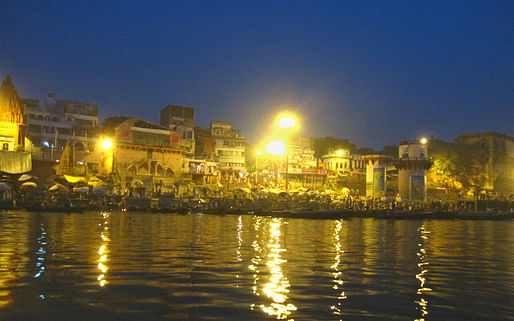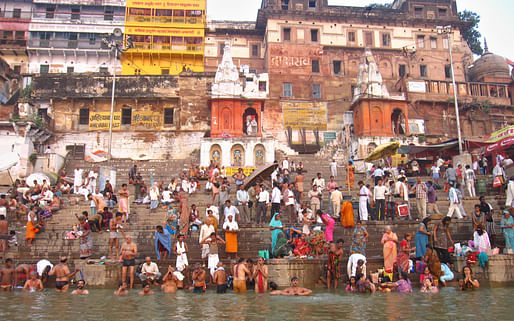
Jul '12 - Jan '13
It's a temple and a trashcan, a crematorium and a food source, a bathtub and a highway, a swimming pool and an art gallery; the local hang out and the workplace, the water fountain and the sewer. It is where the Ganges meets metropolis, the Ghats of Varanasi. Yes, this Ganges is an efficient machine of nature, carrying multitudes of duty with ease, constant and steadfast, it is the lifeline of the city.
Varanasi lies on the west bank of the Ganges and on mornings where the fog is on holiday, it basks in a warm yellow light. A five am boat ride is the tourist highlight and was no doubt in due course. For three hundred rupees one may lease a boat and boatman for two hours time. Amidst the dim streetlights and eerie brume the ghats grow with vitality. The volume of bustle commencing along the Dasashvamedha Ghat at such an hour may pleasantly bewilder one. Perhaps Ganga, the goddess of the Ganges, holds strict time, for at this unearthly hour prayers were in full swing.
The preponderance of this bustle, which presides, may be described as spiritual in nature, relating to both ceremony and the small economy that is supported by it. There is the less provocative ritual of making mud platters and arranging explicit ingredients atop it, like a muddy sushi roll; or the run of the mill, three dunks, a few chants and off to work. If one has spared some rupees, and a splurge is necessary, small boats of leaves carrying tiny candles can be purchased. After more habitual chanting, they are set adrift to be run over by the tourist boats with their prying cameras.
Of the two cremation ghats, Manikarnika Ghat is the larger one and is said to only cremate Hindus. Bodies burn here twenty-four hours a day, although this morning saw few visitors. The smoke is faint from the dying embers and men with bamboo poles stoke the fire from afar. There are three distinct piles here, one made of wood, which is neatly stacked a story high against an adjacent wall. Another of tattered, slovenly ribbons, and ceremonial garb; and a third of black ashes and charcoal. Men gather these ashes in bowls on their heads while moving throughout the ghat, and carry them to the riverside. It is said that the greater your class, the higher upon the ghat you may burn.
There are two buildings that look down upon these flames. They are reserved for the destitute elderly of which no family exists, who will soon reach the end of their journey. With the westwardly winds, they are subjected, with or without ill repute, to the constant whisking of their smoky brotherin. Parts of the façade of the northern most building are stained black, like the temple adjacent, with the smoke of their relatives. Young men give tourists tours of these buildings for donations.
The second cremation ghat is Hrishchandra. This is the more liberal of the two, as non-Hindus may burn along side Hindus. To the south of the burning plots is a morbidly mechanical sort of structure of which two chimneys protrude from. This is the government run electric furnace. Since wood is a rarity in these parts, it can cost upwards of four to five thousand rupees for enough wood to burn a body through and through. The electric furnace is five hundred rupees. Some purchase enough wood to burn the limbs from the body, but nothing more and the effect is an occasional, burnt half corpse floating past your boat. But cremation is reserved for seniority. If one should reach his end from unnatural causes, one is tied to a stone and dropped in the middle of the river.
There was no central planning in the building of these ghats. Each one adheres to its specific purpose and adapts to its sloping topography. This chaotic mismatch might seem Western if walls were erected between them and lawns spawned, but the ghats are a public affair and traversing from on to the next never loses intrigue.
 Dasashvamedha Ghat just before daybreak
Dasashvamedha Ghat just before daybreak
 Ritual bathers
Ritual bathers
 Manikarnika Ghat, her pile of charcoal, blackened temple and two eternal waiting rooms
Manikarnika Ghat, her pile of charcoal, blackened temple and two eternal waiting rooms
 The State Crematorium
The State Crematorium
 Local artwork can be found along the barren ghat walls
Local artwork can be found along the barren ghat walls
 The morning sun, a view from the eastern bank
The morning sun, a view from the eastern bank
An Indo Inquisition is a thirteen-week train expedition across India. The journey will document the influences of international modernism and British occupation, as well as compare the effects of wealth accumulation, culture, religion, and poverty with economic growth and their effect on the built environment.
No Comments
Block this user
Are you sure you want to block this user and hide all related comments throughout the site?
Archinect
This is your first comment on Archinect. Your comment will be visible once approved.